Blue Planet by First Edition Arts
The strummed tambura wafts in through arresting scenery, the sounds of birds, critters and water, as musicians perform in carefully curated natural, outdoor settings. Filmed across India, First Edition Arts’(FEA) Blue Planet series, launching today evening, hopes to highlight the connections between the living ecology of the planet and the ecology of the classical arts. Blue Planet is filmed in beautiful locales including forests, groves and around water bodies.
Devina Dutt of FEA says the impetus arose from the environmental campaign Amche Mollem in Goa, which was started some 18 months ago by young artists, environmentalists and citizens and recently won the Sanctuary Wildlife Campaign Award. “We have been consulting with them regularly. Their thoughts on why ecology concerns everyone and is not just the preserve of environmentalists matches perfectly with our own thoughts. It was this campaign and its use of the arts, alongside the legal and scientific arguments, against the government’s plans to clear forests for infrastructure projects, that crystallised the idea of the Blue Planet series for us.”
A version of this article appeared in The Hindu newspaper dated December 17, 2021. All media on this page are courtesy Ms. Devina Dutt of First Edition Arts. Appended to the end are notes that she sent to give me a ‘picture’ of what happened during some of the shoots. Rather than my paraphrasing what she said, I thought her first hand account would add vivid colour and extra detail for interested readers.
Started in 2014, FEA was one of the earliest in the space of well-produced and curated online programs of Indian Classical Music, well before the pandemic made it a necessity. “We created FEA with a desire of doing something across multiple artforms, ideally combining them with our passions for other causes too,” says Devina. “However, our initial foray into Indian Classical Music proved so all-encompassing that we had little time to engage with anything else.” Blue Planet brings together their passions for the environment and multiple classical art forms.
Devina believes that the live experience can never be replicated online, for that is about communion with friends and others. On the other hand, digital media can be used as a medium by itself to create experiences that do not happen in the live format. The camera can go into a green room or overhear conversations in a car between two musicians. Film can be its own unique creative exercise.”

Blue Planet, FEA’s most ambitious project yet, is filmed in less travelled parts of the country. By taking music and musicians from outside their world to unique and threatened habitats on the literal outside, FEA hopes to pull the classical arts ecosystem out of its insular bubble. Participating and engaging with the episodes, they hope, will foster an awareness of environmental and social causes in both the artistes and the audience.
“It is not a gimmick and we are not using the environment as a buzz-word. We are content with the subtle statement made by just placing the musicians in the locales. Nature slows down time for us just as does classical music, highlighting the need to nurture both the arts and the physical environment.” Devina hoped the artistes and the FEA team could all learn something from their travels together. While each episode is primarily a concert, also woven in are vignettes from their journeys and the experiential textures of the places, people and issues.
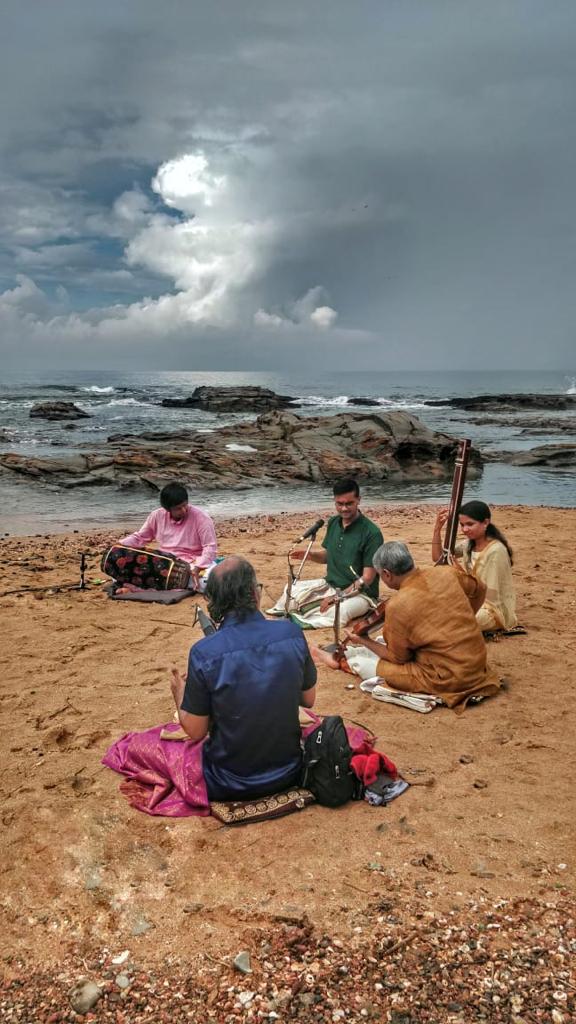
Photo courtesy: Sri. Hariharan Sankaran via Ms. Devina Dutt.
The FEA team is personally passionate about the environment and is regularly in touch with experts, activists and journalists who stay atop of this field. It was in consultation with these, and some of the artistes as well, that they zeroed in on the sites to film and issues to highlight. They were made aware of the Nagaland location, for example, by vocalist Aishwarya Vidhya Raghunath whose husband, Jayesh Ganesh, an architect, and his friend, Uday Goswami, were key in building a community centre at Angangba, using local, sustainable materials. Angangba is in Nagaland’s Tuensang district which is one of the 250 most backward in India. Vocalist T.M. Krishna engaged with Sethrichem Sangtam, a grassroots social activist there, who discusses challenges stemming from a long tradition of jhoom cultivation (slash and burn). Sangtam’s Better Life Foundation is trying to encourage the community to switch to more sustainable agricultural practices.
To minimise carbon footprint, FEA has consciously filmed artistes, in most cases, in locations not too far from their states of residence, whilst spotlighting various issues. “The episode featuring A Carnatic Quartet will be a grittier film that alternates between the stark urban devastation of Ennore and North Chennai with the fragile beauty of Pulicat and the mangroves. To showcase issues caused by the recent extreme weather patterns, the Malladi Brothers will be filmed in Urur Olcott Beach.” K.S. Vishnudev’s episode will be filmed in the Gurukula sanctuary in Wayanad – a 60-acre painstakingly nurtured rainforest habitat that preserves flora and fauna. Ramakrishnan Murthy’s episode is set in the Anjuna tide pools of Goa where marine conservationist Gabriella D’Cruz explains the importance of seaweed cultivation and other ecological issues.
As to why the title, Blue Planet, Devina explains, “In outer space our planet looks blue. Hence, taking the long view and the outside perspective, we thought blue planet worked. We were also thinking of calling it One World but we felt Blue Planet was closer to the idea of the physical world, its fragility and its beauty.”
Besides weather disruptions and more, filming in the open comes with its own challenges that require extensive planning. Permissions have to be obtained to film in each location. Local assistance and help have to be sought and arranged, usually remotely. Technologically, battery operated equipment was required that could be set up literally anywhere. As simple as it all might sound, it entailed a lot of work pre and post shoot. Those battery packs needed recharging upon return. All audio and video files, huge ones, had to be downloaded immediately after the day’s filming, upon arrival at the base camp, to make room for the subsequent day’s filming. All files were saved in triplicate to avoid accidental deletion. Despite all this, the FEA team and the musicians maintained a spirit of spontaneity, making the most of opportunities and adapting as needed.

Clockwise from bottom left: Aishwarya Vidhya Raghunath, G. Chandrasekara Sharma, Praveen Sparsh and Brindha Manickavasakan.
The programs in Blue Planet feature Hindustani (Dhrupad and Khayal) and Carnatic music, Bharatanatyam, vocal, instrumental and jugalbandhis. FEA will air five 90-120 minute episodes on Shaale.com, one weekend a month, through March 2022. All episodes will then be available for viewing until May 31st. The line-up begins today at 7 pm with two concerts – Dhrupad Vocal by Uday Bhawalkar and Carnatic Vocal by Ramakrishnan Murthy. Tomorrow features Khayal Vocal by Shubhada Paradkar, followed by a Carnatic Vocal duet by Aishwarya Vidhya Raghunath and Brindha Manickavasakan. T.M. Krishna’s Carnatic Vocal episode will be aired on Sunday.
Other episodes showcase Budhaditya Mukherjee (Hindustani Surbahar and Sitar), Dr. Ashwini Bhide Deshpande (Hindustani Khayal Vocal), Abhishek Borkar (Hindustani Sarod) with Ramana Balachandran (Carnatic Veena), Mohi Baha’ud-din Dagar (Rudraveena – Dhrupad), Dr. Pantula Rama (Carnatic Vocal), Waseem Ahmed Khan (Hindustani Khayal Vocal), K.S. Vishnudev (Carnatic Vocal), Venkatesh Kumar (Hindustani Khayal Vocal), Abhishek Raghuram (Carnatic Vocal), Ulhas Kashalkar (Hindustani Khayal Vocal), Rithvik Raja with Shweta Prachande (Carnatic Vocal and Bharatanatyam), Debashish Bhattacharya (Hindustani Sarod), Vignesh Ishwar with Christopher Gurusamy (Carnatic Vocal and Bharatanatyam) and P. Unnikrishnan (Carnatic Vocal).
To promote the series, FEA, sometimes in conjunction with the artistes, has selected poems in English, Tamil, Bangla, Kannada, Hindi, Sanskrit, Telugu and Marathi that the artistes read in a tongue they are familiar with. “They cover nature and other topics common to all humankind.” Further, the Amche Mollem visual artistes are creating a unique, original hand painted poster for each concert. At the conclusion of the series, the posters will be auctioned off with the entire proceeds given to the visual artistes.
Tickets for individual episodes range from Rs. 1,000 to Rs. 2,000 or US$25-$35. A season pass is $200 or Rs. 14,000 but is available for $100 or Rs. 10,000 if purchased through organisations/groups that are willing to commit to purchasing at least 50 tickets. Available at https://shaale.com/watch/blueplanet
“If the musical community can begin to see analogies between their own world and the wider universe, and with the state of the natural world in particular, we would have met a large part of our objective,” says Devina Dutt.
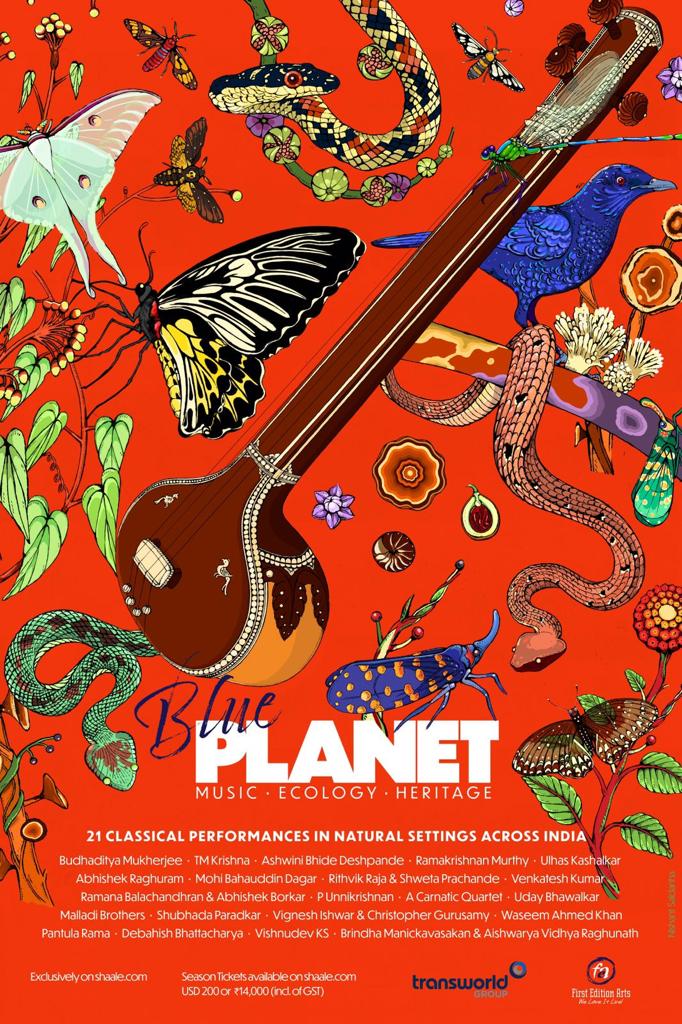
Devina Dutt’s Notes:
Nagaland:
“This schedule had two sets of Carnatic vocalists. TM Krishna was one and there was a duet between Aishwarya Vidhya Raghunath and Brindha Manickavasakan. The co artists, younger more adventurous musicians included Praveen Sparsh, Vittal Rangan and Chandrasekara Sharma. I came to know about Better Life foundation and its founder Sethrichem Sangtam of Angangba village in Tuensang district of East Nagaland. I was told about the NGO and the place by Aishwarya Vidya Raghunath whose husband Jayesh Ganesh is an architect and who had designed the Farmers Innovation Centre in the village. They sent me photos and we began to talk to Sethrichem for at least 4 months. The more I spoke to him the more I warmed to the idea of going there. It was a daunting trip to even plan. We were 18 people in all including artists and we had people travelling from Mumbai, Chennai and Kolkata. Our destination was a 12 hour drive from Dimapur on very bad roads. We decided to break the journey by flying to Jorhat in Assam and driving four five hours plus on very bad roads to a town called Mokokchung in Nagaland. We were relieved for the break that night and sank into instant slumber at Hotel Metsuben. Although more than half of the group were vegetarians and anxious about the food we would get in Nagaland, the hotel served very good veg food. All the MTR packets and podis were not needed!
Next day we set out for the five hour journey from Mokokchung to Tuensang. On the way, we had to stop because of road repairs. That is when our promo recording of Highway bhairavi happened.
We reached Tuensang at about 4 pm and were warmly received by Sethri and his family as well as volunteers. We stayed in the three rooms at the office and the new guesthouse as well as in tents in the Farmers Innovation Centre (FIC). Sunset stole upon us at 4.30 pm! We gathered into the warm and inviting kitchen with a log fire blazing. Our hosts were hard at work trying to make alu parathas for the first time for us served with mango pickle. We realised that in all Naga homes the kitchen is the heart of the home. Next day we went for a walk in and around the Farmers Innovation Centre looking for locations. Since it was Sunday our hosts and the entire community were in Church. We decided to be there as well. Earlier that day the District Commissioner, a fine young gentleman from Bihar, Mr Ramakant had dropped in at the FIC to meet us and discuss the talk he was delivering at a meeting of village Elders after the Church Service in which he was exhorting villagers to get themselves vaccinated. We ie crew and the artists too explored the church, joined in the singing and also simultaneously went about exploring and deciding on concert locations in the village of Angangba. It all felt very new and fresh and exciting.
We also explored one of the oldest forests in the area called the Rhododendron Forest with very old and tall pine trees. The forest was dense and dark. We would have loved to film a concert there but the terrain was steep and there was no clearing.
The next day we filmed with Krishna in the open courtyard of a home in Angangba with an audience of curious neighbours. We had selected 2 locations for Krishna and so we decided that during the tanee avaratan he and his artists would be shown walking to the next location, meeting and drinking tea with villagers with the soundtrack playing over that clip. The musicians spent a couple of hours working on that bridge music the previous day.
We returned to the FIC by lunch time. And then it was dark. Once again, we found ourselves in the kitchen that evening chatting, drinking endless cups of tea and taking turns to cook a simple one pot meal like a khichdi or soup and noodles!
Krishna also did a Walk the talk type interview of Sethri where they discussed the objectives of the Better Life Foundation, the historical challenges bequeathed by a long tradition of hunting and jhoom (slash and burn) cultivation practiced by people in the region. Sethri explained the grassroots changes he and his group had tried to bring about in the community by encouraging them to switch to more sustainable agricultural practices.
The next day we filmed the Carnatic vocal concert with Brindha and Aishwarya at another location in the village. As on the previous day we were amazed by the way in which volunteers and villagers stepped in to help us carry equipment, bring chairs and offer tea without us ever having to ask them. We were truly struck and moved by their hospitality.
Krishna then went off on a half day trek with a guide. That evening we attended a tribal dance that the village put together for us.
The next day we had some musicians speaking to Sethri about the Farmers Innovation Centre at the Centre. Mr Sethri also took us to the adjoining village of Chungtor where he was born. We walked about the village meeting weavers and village elders and also listening to a demo of the tribal log drum. Next, we went to the home and farm of a Champion Farmer who had grafted many hybrid varieties successfully. We came back in time for a quick lunch and tearful goodbyes.”
Maharashtra and Goa:
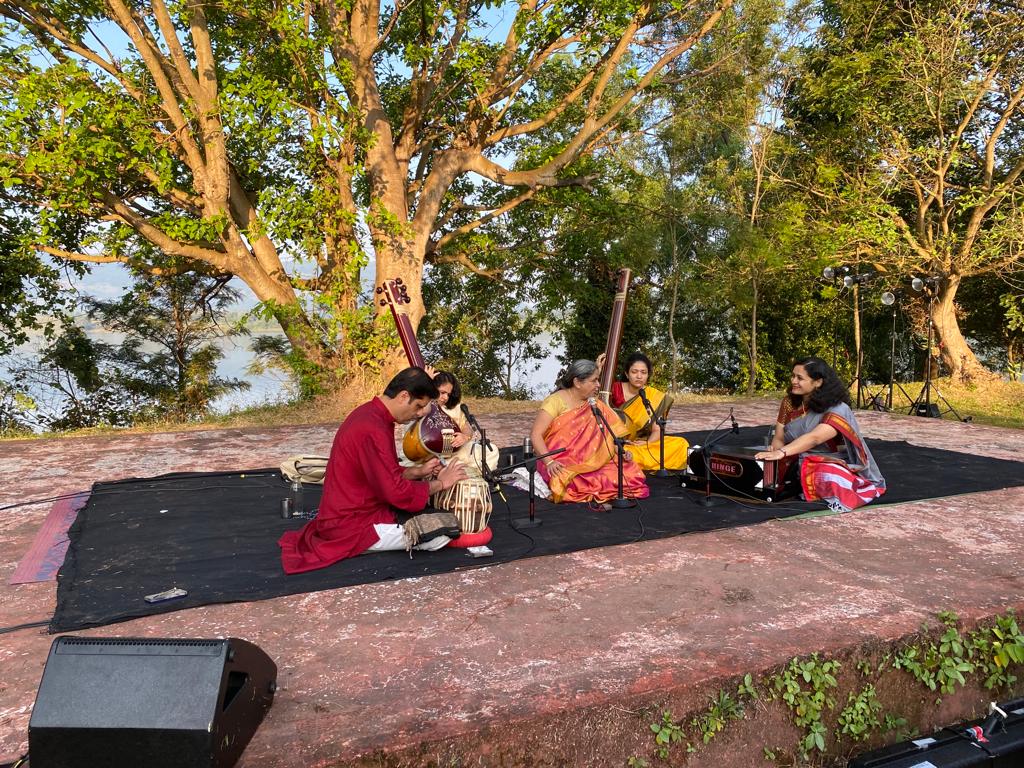
“Our very first shoot in late October entailed a three hour drive from our base in Mumbai to The Company Theatre in a fairly remote village of Uksan in Kamshet set in the rural landscape of the Western Ghats. The 5 acre plus space is a residential arts and specially theatre facility founded by theatre actor Atul Kumar. We were happy to be taken around the space by Atul who was reading for a play with a group of actors. The musicians, the senior Hindustani vocalist Shubhada Paradkar came with two of her senior students. They were her daughter Rashmi Sule and Aishwarya Rao. On tabla there was Mandar Puranik and on harmonium we had Supriya Joshi. Everyone is based in Mumbai so it was a 3 hour trek. The musicians all described the moment they actually saw the space and exclaimed at its natural beauty with the lake and the hills and abundance of fruit trees! Arriving just before lunch we had plenty of time for walks around the campus, an inspection of the location by the lake for the concert next morning and a small practice session too. The concert was filmed next morning between 8 and 10 am. Both students played the tanpuras they had brought along from Mumbai and also sang along.
After the concert, we took Shubhada ji for a walk down to the lake. She was kind enough to read a Marathi poem by GD Madgulkar.
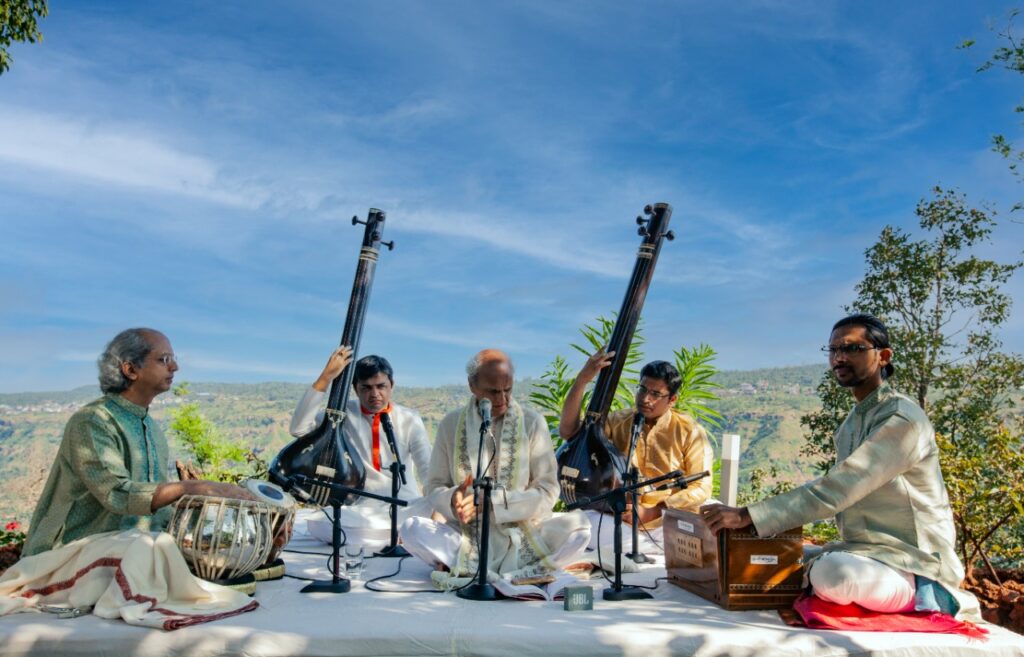
On location in Mahabaleshwar, Maharashtra.
After lunch the artists went back to Mumbai and our team of about 12 people went on to Mahabaleshwar, a three hour drive into the Western Ghats for our next concert with Ulhas Kashalkar. This was an early morning concert in the home of Jaisinh Mariwala or Jaisinh bhai as he is known in Hindustani circles. Jaisinh bhai is in his late 80s and is a patron and connoisseur of Hindustani music. He has memories of attending concerts by stalwarts like Faiyyaz Khan and Abdul Kareem Khan in Mumbai as a six year old thanks to his music-loving parents. Jaisinh bhai has been living in Mahabaleshwar and tending his 11 acre organic farm for the last 3 decades. He speaks about how listening to music in the open, in the garden and in the farm overlooking the Ghats, has taught him how to live alone and away from the city. Since he is a particular fan of Ulhas ji, we asked him if we could set this concert in his garden. He agreed immediately and when we reached there that night, we found he had selected the perfect spot between two trees at the edge of his garden with a sweeping view of the hills and valley below. He asked if he could invite a handful of guests and so we had an audience of about 20 people with many having driven down from Mumbai or Pune. On tabla, we had the marvellous Yogesh Samsi and on harmonium we had Tanmay Deochake. After the concert, we had a conversation between Jainsinh bhai and Ulhas ji. Jaisinh bhai took us around his farm and introduced us to his co farmers.
Goa
The next day we left for Goa. This was a long journey of about 8 hours! Since we were filming inside the Mollem National Park which is on the edges of the state and about 80 km away from Panjim it was a very different Goa experience for everyone. Dhrupad Maestros Uday Bhawalkar and Bahauddin Dagar had both driven down from Pune and Mumbai respectively. We stayed in the state government owned resort which was the only place close to the forest. We had obtained permission from the Forest Department to film within the forest and we were able to go into the forest, a 40 minute walk which entailed crossing streams, and negotiating slippery rocks! We were working with young environmentalists from Goa who had played a key role in the successful campaign to protest the central government’s plans. Some of them came to the forest and were intrigued by the sound of the pakhawaj in the forest. (Our sound teams were given a table to set up alongside the artists on a patch of raised ground but our 4 cameramen, gimble operator as well as director stood in knee deep water in the stream throughout the concert!)
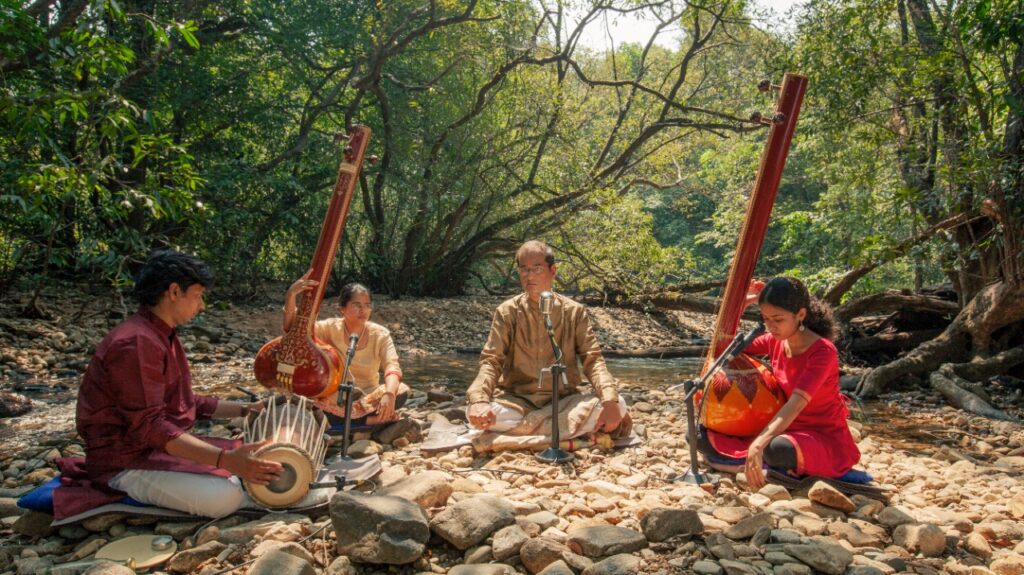
These same environmentalists were also the visual artists who we had commissioned to create posters for each concert and we had been in conversation with them for the past 3 months. Most of their questions were about the music and musicians as they tried to find a way of understanding the music and its purpose and to create posters based on their understanding of the music! Many of these young environmentalists/visual artists dropped in for the concert. Some of them spoke to Uday ji in between during breaks in the recording. We also asked them to explain the significance of Mollem Forest to Goa and why this particular movement had managed to galvanise all sections of society in Goa. We recorded Uday ji’s mid morning concert with the sound of birds chirping and a stream! It was quite a trek for him and his co artists carrying the 2 tanpuras too for the 30 minute or so walk into the forest but they were smitten by the place! Later, Uday ji also read a poem by the eminent Hindi poet Kunwar Narayan.
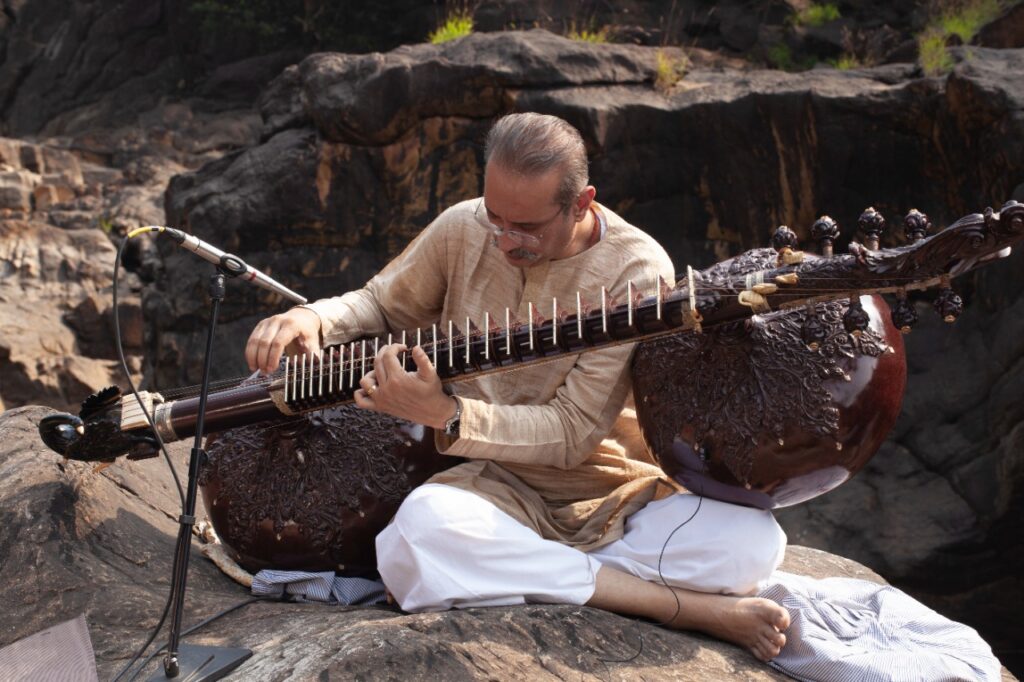
The next day we filmed a concert with Bahauddin Dagar and Pratap Awad on pakhawaj in Mollem but on the other side of the forest and with a completely different look. This location was an elevated ridge with a deep water body said to be infested with crocodiles! Since we had taken permission from the Forest Department we had all safety measures and plenty of forest guards around.
Beautiful!
Thank you